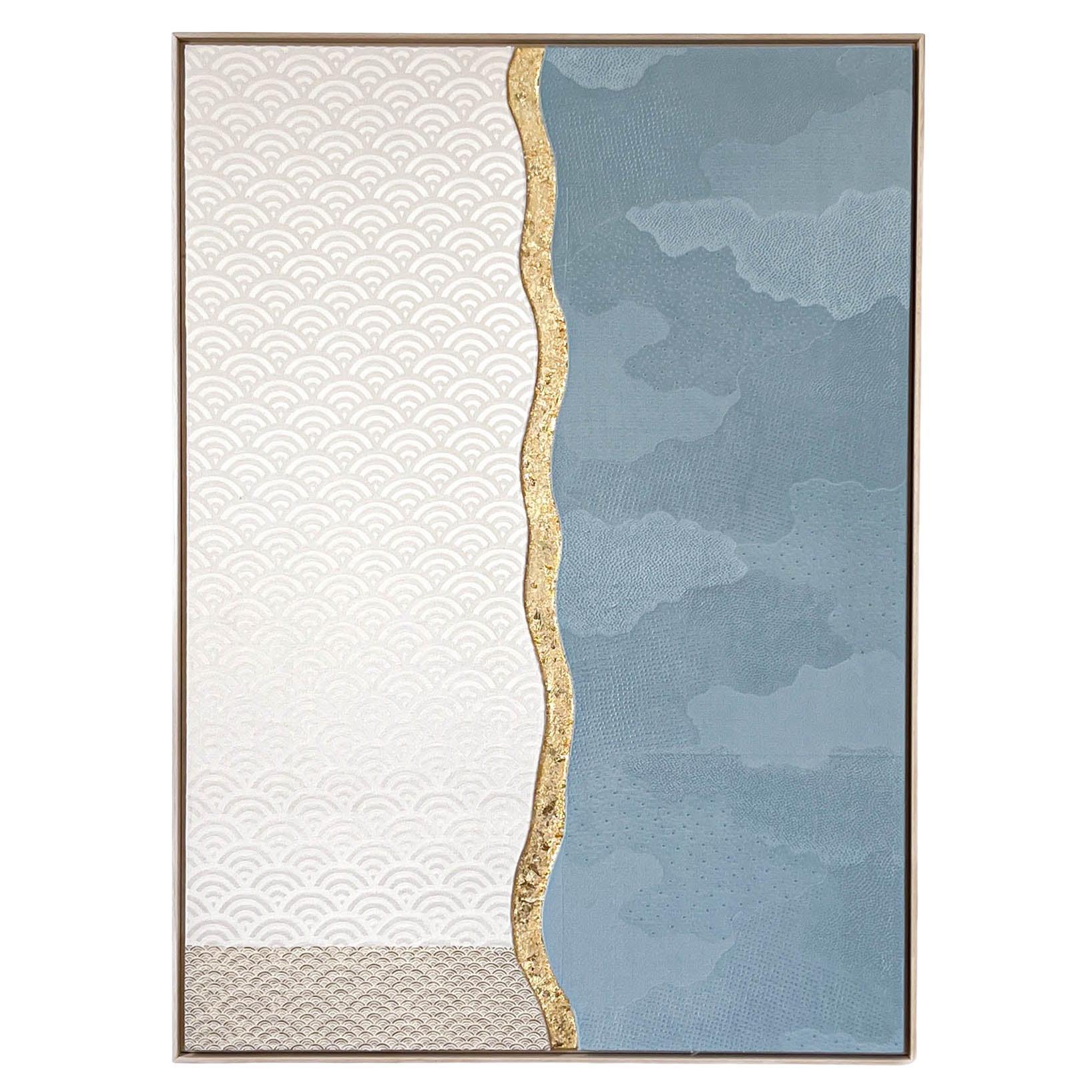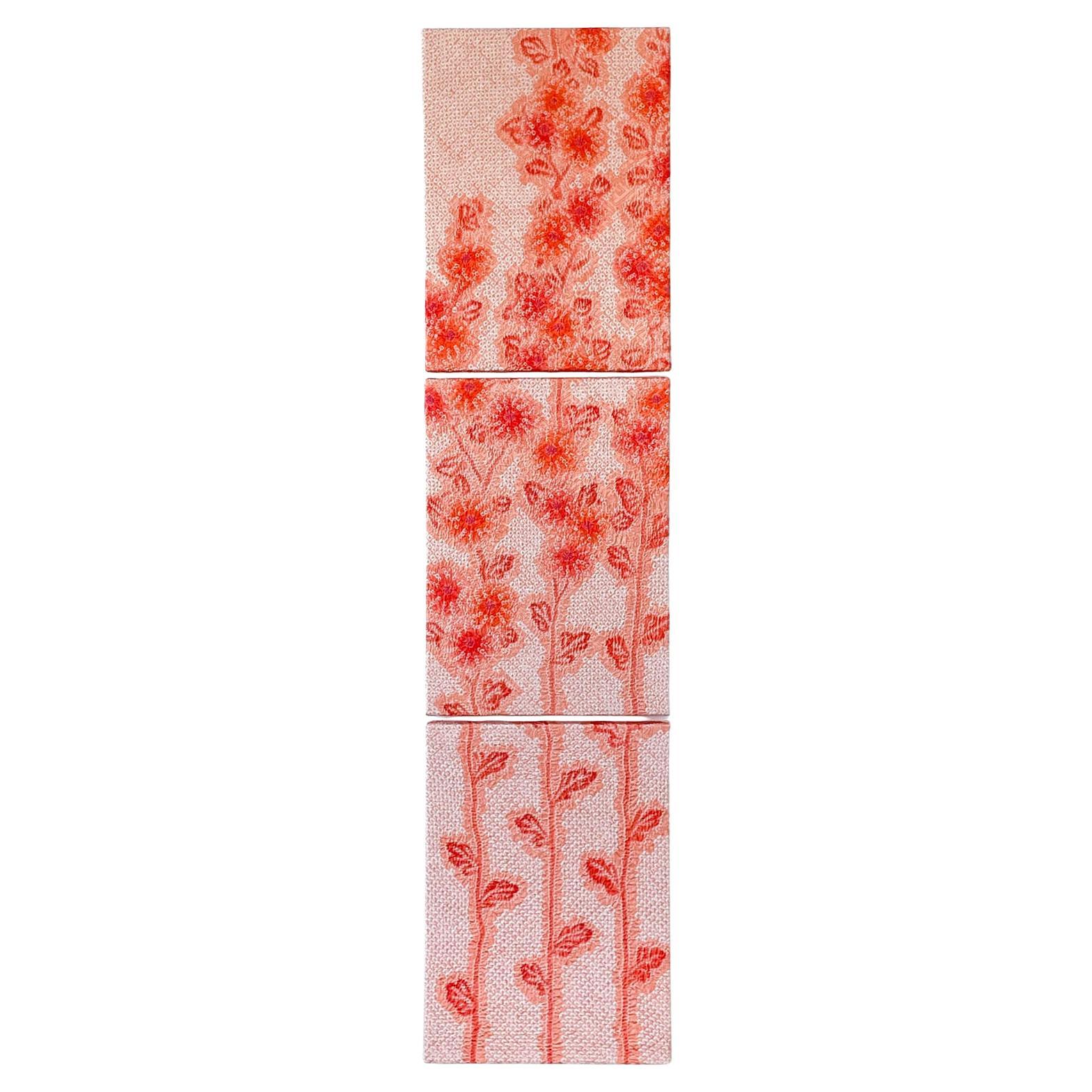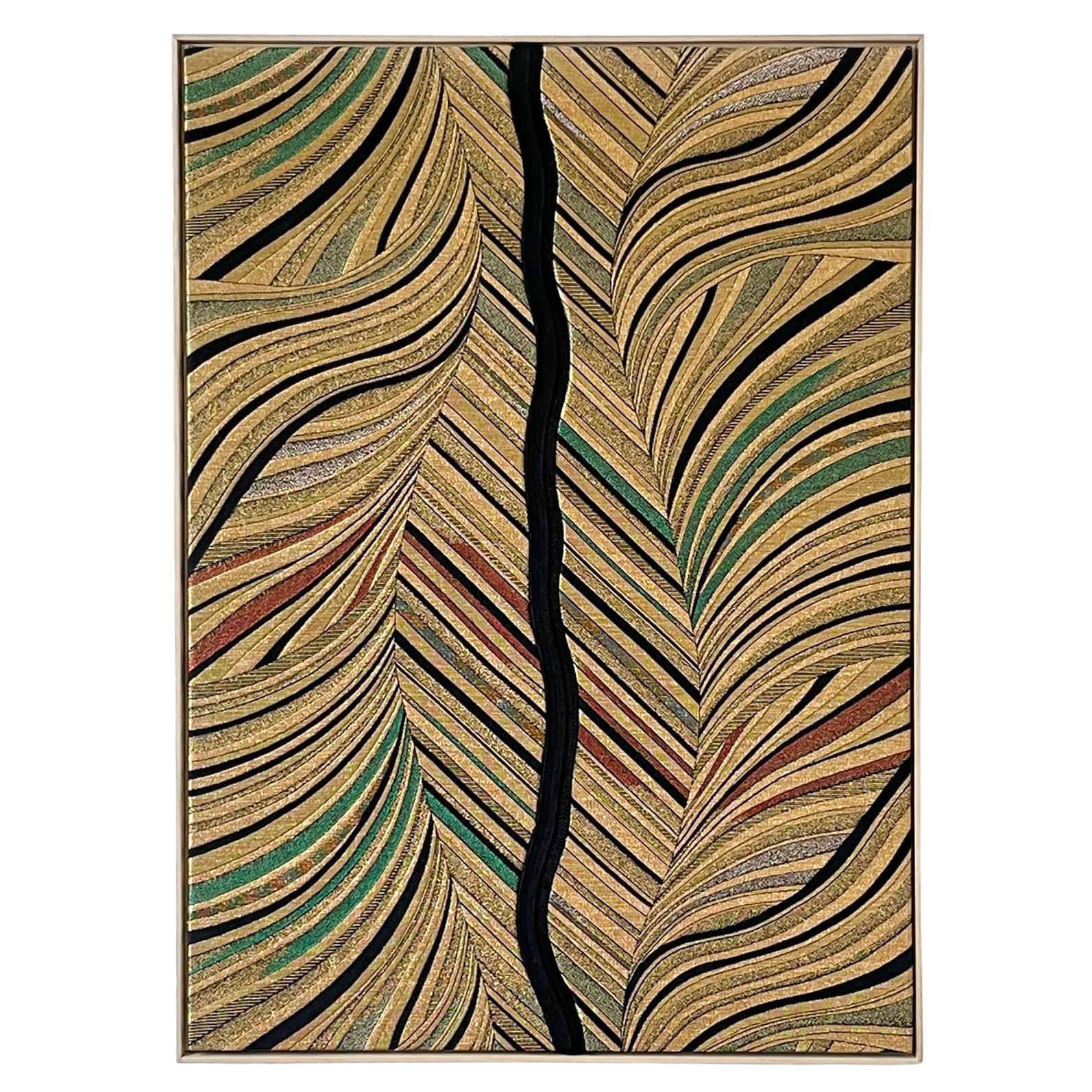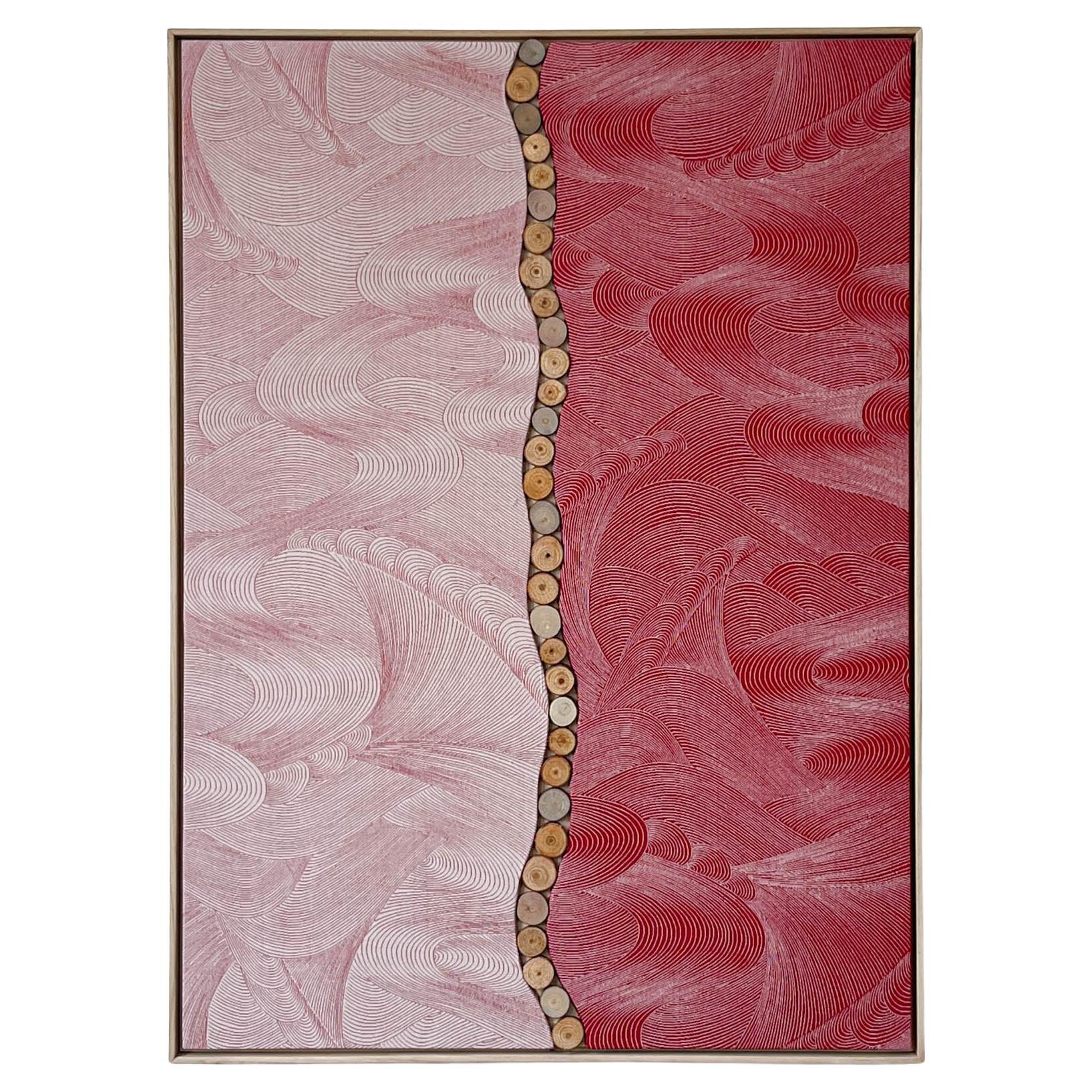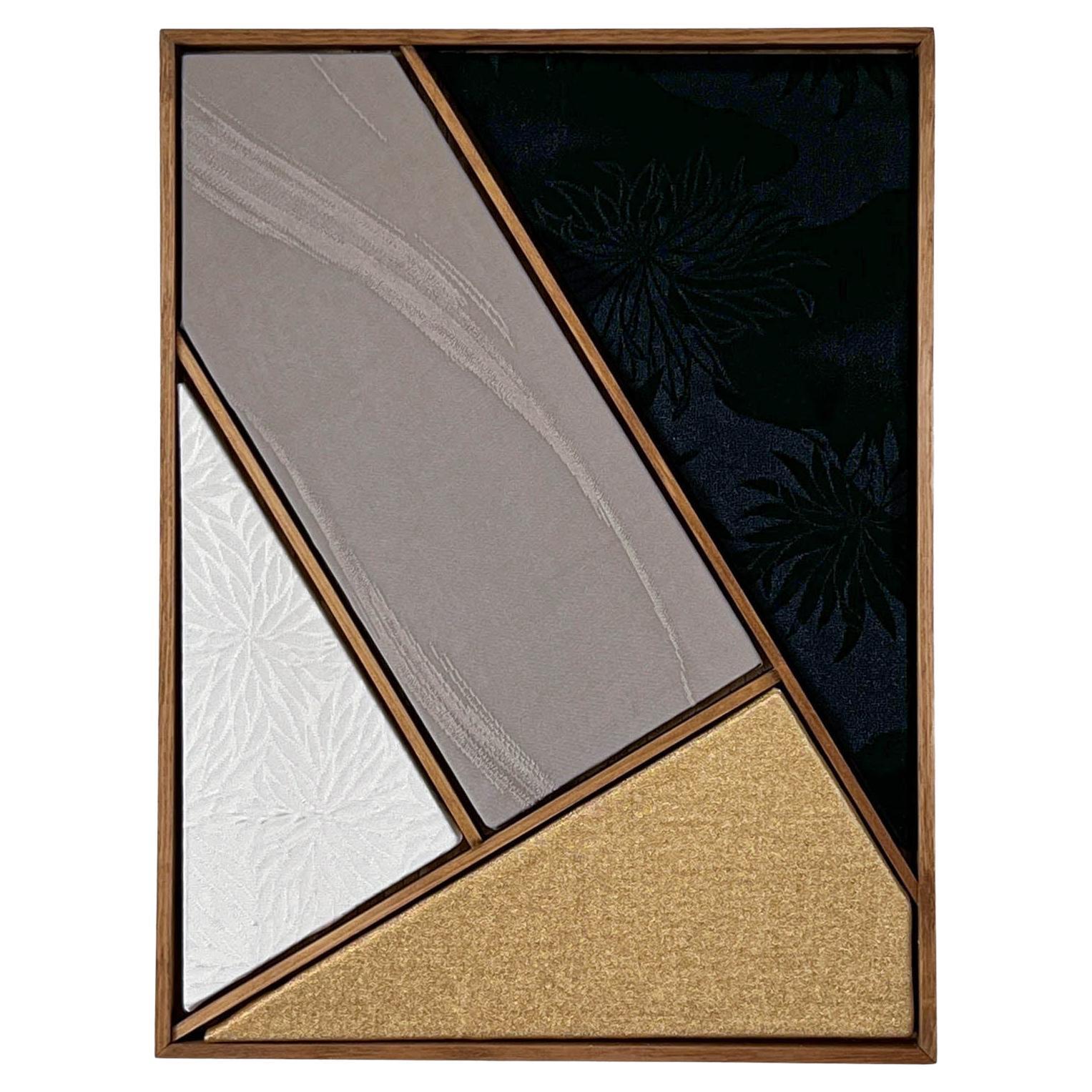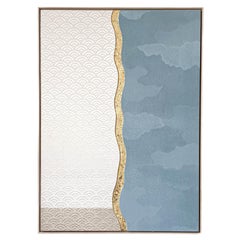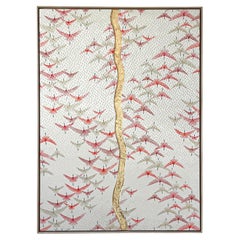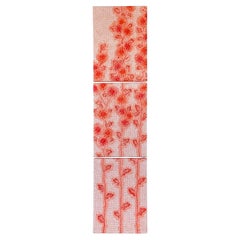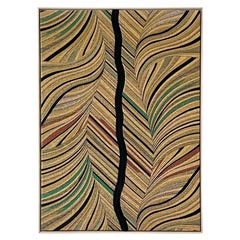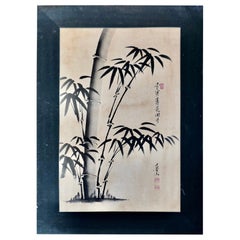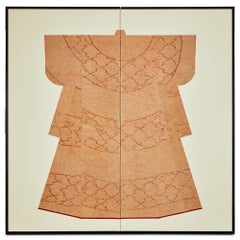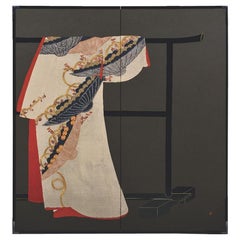Items Similar to Vintage kimono textile art "Autumn branches ~ Kintsugi ~" by ikasu Brown, Japan
Want more images or videos?
Request additional images or videos from the seller
1 of 12
Vintage kimono textile art "Autumn branches ~ Kintsugi ~" by ikasu Brown, Japan
About the Item
The frame for this work is made of paulownia wood taken from antique Kiritansu - chest-of-drawers for kimono.
I use antique kiritansu that can’t be used as furniture anymore to create basis and frames for my works. It adds them even more authentic atmosphere of traditional wabisabi spirit. Can you feel it?
The piece uses the concept of "kintsugi" - it "unites" the pieces of antique kimono back together with golden washi paper to give it a second wind as art work.
<< Period / Story >>
The kimono used in this piece was originally crafted during the late Showa period (1960-80ies).
<< Explanation of colors and patterns >>
This piece features a modern arrangement with gold Japanese traditional washi paper running through the shades of brown stripes depicting branches and leaves.
The shades of brown stripes, upon closer inspection, reveal intricate "fawn pattern 鹿の子模様" dyeing, adding depth and complexity to the design. The origin of the "fawn pattern" lies in a tie-dyeing technique called "fawn pattern tie-dyeing," where the cloth is folded into quarters around a circular point and repeatedly tied with thread about seven to eight times before dyeing. The areas tied with thread remain white and square-shaped, with the tips of the corners lightly dyed to appear as dots, resembling the white spotted patterns on a fawn's back, hence the name. Deer are considered messengers of the gods and symbols of good fortune, vitality, and fertility, often used to represent "prosperity in descendants."
The depicted branches and leaves are delicately outlined with gold leaf, making the pattern stand out from the background and adding subtle elegance.
During the late Edo period (19th cent.), the shogunate enacted laws prohibiting luxury, leading townspeople in Edo to incorporate delicate nuances into dark colors like brown and gray, resulting in a wide range of colors and new "color names" being coined on various occasions, creating a diverse array of colors known as "Forty-eight Teas and a Hundred Mice 四十八茶百鼠."
<< Characteristics of the fabric >>
"Kimpaku" (金箔) -technique of gold dyeing on leaves, refers to the application of gold leaf onto various surfaces. In the context of kimono, kimpaku is used as a decorative technique to add luxuriousness, elegance, and a sense of opulence to the textile. Kimpaku is used to create intricate patterns, motifs, or designs, adding shimmering accents and highlights.
Kimpaku is used here to embellish traditional motif of leavevs, enhancing the overall aesthetic appeal of the fabric.
The process of applying kimpaku requires skill and precision. Ultra-thin sheets of gold leaf are carefully adhered to the fabric using an adhesive. Artisans use specialized techniques such as hand-painting or stenciling to create the desired design before applying the gold leaf. After the gold leaf is applied, it is delicately burnished to ensure a smooth and even finish.
Kimpaku has been used in Japanese textiles for centuries, particularly in garments worn by the nobility and aristocracy. Today, it continues to be employed in the creation of high-end kimono for special occasions such as weddings, ceremonies, or formal events, like this piece.
The use of kimpaku in kimono represents a fusion of artistic expression, craftsmanship, and cultural tradition. It serves as a symbol of wealth, prosperity, and refinement, adding a touch of extravagance to the fabric and elevating its status as a work of art.
<< About the frame >>
This artwork frame is crafted from paulownia wood, a uniquely Japanese material closely tied to the world of kimonos, and it serves to convey the refined beauty of Japanese nature.
Paulownia wood is known as the lightest wood in Japan, prased for its natural luster, resistance to moisture, and resilience against cracking. Since ancient times, it has been used in crafting furniture, chests, and musical instruments.
Paulownia wood is closely linked to kimono culture. During the Edo period, it became customary to store cherished kimonos in paulownia chests, which offered fire resistance and protection from moisture and insects.
Traditionally, when a daughter was born, a paulownia tree would be planted. Upon her marriage, the tree would be cut down, and the wood would be used to craft a chest for her as a wedding gift.
Following the Ansei Earthquake during the late Edo period in 1855, paulownia chests gained popularity due to their ability to withstand fires and even float in water, thereby safeguarding their contents during floods.
- Creator:Kimono ikasu (Artist)
- Dimensions:Height: 28.75 in (73 cm)Width: 20.87 in (53 cm)Depth: 1.97 in (5 cm)
- Style:Japonisme (In the Style Of)
- Materials and Techniques:
- Place of Origin:
- Period:
- Date of Manufacture:around 1960ies
- Condition:
- Seller Location:Setagaya City, JP
- Reference Number:1stDibs: LU10079243303632
About the Seller
New to 1stDibs
Joined in the past six months.
No Reviews Yet
Vetted Professional Seller
Every seller passes strict standards for authenticity and reliability
1stDibs seller since 2024
- ShippingRetrieving quote...Shipping from: Setagaya City, Japan
- Return Policy
Authenticity Guarantee
In the unlikely event there’s an issue with an item’s authenticity, contact us within 1 year for a full refund. DetailsMoney-Back Guarantee
If your item is not as described, is damaged in transit, or does not arrive, contact us within 7 days for a full refund. Details24-Hour Cancellation
You have a 24-hour grace period in which to reconsider your purchase, with no questions asked.Vetted Professional Sellers
Our world-class sellers must adhere to strict standards for service and quality, maintaining the integrity of our listings.Price-Match Guarantee
If you find that a seller listed the same item for a lower price elsewhere, we’ll match it.Trusted Global Delivery
Our best-in-class carrier network provides specialized shipping options worldwide, including custom delivery.More From This Seller
View AllVintage kimono textile art " Seaside ~ Kintsugi ~ " by ikasu White/Blue Japan
By Kimono ikasu
Located in Setagaya City, JP
This work is inspired by the sea and the sky, uses golden leafing as a creative point, framed in paulownia wood originally used for a kimono chest-of-drawers.
In this artwork, the aim was to capture the splendor of Japanese nature, showing the sea, sky, and forests. Traditional Japanese culture, represented by the kimono, and wood, an integral element of Japanese craftsmanship, were used to bring this vision to life.
I used two pieces of kimono that could no longer be used as clothing and bark that would normally be discarded to create the ultimate upcycled piece.
The marriage of Japanese natural materials - silk, paulownia (frame), and pine (branch slices for the center decoration) - and Japanese natural patterns - blue ocean waves and clouds - expresses the magnificent beauty of Japanese nature from various angles.
The central golden leaf decoration stands out as a distinctive feature of this work. The piece uses the concept of "kintsugi" - it "unites" the pieces of antique kimono back together with golden leaf to give it a second wind as art work.
<< Period / Story >>
The kimono used in this piece was originally crafted during the late Showa period (1960-80ies).
<< Explanation and meaning of pattern and colors >>
The kimonos on this canvas have been creatively repurposed into interior artwork. The one on the left represents ocean wave pattern.
Seigaiha waves is regarded as a pattern of good fortune, embodying wishes for eternal happiness and a tranquil life for future generations.
The fabric on the right is embellished with cloud patterns woven in various techniques. Clouds, with their ever-shifting shapes and colors, have long intrigued people as signs of big events or omens.
<< Characteristics of the fabric >>
The kimono used for a part on the left has a lustrous, ivory-colored ground that serves as a backdrop for the vibrant ocean wave pattern expressed through the ground pattern.
On the right fabric, the cloud pattern is beautifully rendered by dyeing both the plain fabric and delicate patterns. This is achieved through the so-called "Yose-komon" technique, where each cloud is adorned with small patterns such as hail, sharks skin pattern, and other intricate details.
Edo komon, created using a refined and advanced dyeing technique that appears as a solid color from a distance, originated during the Edo period (1603-1868) and remains highly popular as formal kimono attire to this day.
<< About the frame >>
Kiritansu - chest-of-drawers for kimono, is traditionally made from paulownia wood, a uniquely Japanese material closely tied to the world of kimonos.
Paulownia wood is known as the lightest wood in Japan, prased for its natural luster, resistance to moisture, and resilience against cracking. Since ancient times, it has been used in crafting furniture, chests, and musical instruments.
During the Edo period, it became customary to store cherished kimonos in paulownia chests...
Category
Late 20th Century Japanese Japonisme Paintings and Screens
Materials
Gold Leaf
Vintage kimono textile art " Cranes ~ Kintsugi ~ " by ikasu White/Red/Gold Japan
By Kimono ikasu
Located in Setagaya City, JP
The frame for this work is made of paulownia wood taken from antique Kiritansu - chest-of-drawers for kimono.
I use antique kiritansu that can’t be used as furniture anymore to create basis and frames for my works. It adds them even more authentic atmosphere of traditional wabisabi spirit. Can you feel it?
The piece uses the concept of "kintsugi" - it "unites" the pieces of antique kimono back together with golden leaf to give it a second wind as art work.
<< Period / Story >>
The kimono used in this piece was originally crafted during the late Showa period (1960-80ies).
<< Explanation and meaning of pattern and colors >>
The Japanese saying goes, "A crane lives a thousand years, a tortoise lives ten thousand years," making cranes a symbol of longevity.
Cranes are also known for staying with the same partner for their entire lives, which is why they are often used at weddings and other celebrations to symbolize "marital bliss" and the desire for harmony between husband and wife.
On this particular piece, cranes are flying through snow woven on the fabric, as if they are overcoming all the disasters to get to their beloved ones.
The color scarlet, or deeply dyed red, used for the most of the cranes here, has long been associated with the meaning of "warding off evil." It is believed to possess the power to repel malevolent forces and invite good fortune.
During the Heian period, scarlet was reserved for sacred buildings and ceremonial objects that held great significance. Ordinary people were prohibited from wearing scarlet-red kimonos, which made it a highly special color.
<< Characteristics of the fabric >>
Cranes, going up and down, are generously decorated by kimpaku here. "Kimpaku" (金箔) refers to gold leaf/foil in Japanese. Gold leaf is a traditional material used in various aspects of Japanese culture, including art, crafts, and even in culinary applications.
In traditional Japanese art, gold leaf is often applied to religious objects, sculptures, paintings, and lacquerware to create a luxurious and decorative effect. The use of gold leaf in art dates back centuries and is associated with a sense of wealth, prestige, and the divine.
Traditional kimpaku technique is used here to make an accent decoration in the middle.
<< About the frame >>
This artwork frame is crafted from paulownia wood, a uniquely Japanese material closely tied to the world of kimonos, and it serves to convey the refined beauty of Japanese nature.
Paulownia wood is known as the lightest wood in Japan, prased for its natural luster, resistance to moisture, and resilience against cracking. Since ancient times, it has been used in crafting furniture, chests, and musical instruments.
Paulownia wood is closely linked to kimono culture. During the Edo period, it became customary to store cherished kimonos in paulownia chests...
Category
Late 20th Century Japanese Japonisme Paintings and Screens
Materials
Gold Leaf
Vintage kimono textile art " Growing ~ Longevity ~ " by ikasu Pink, Japan
By Kimono ikasu
Located in Setagaya City, JP
<< About this canvas >>
This set is a depiction of a tall chrysanthemum stem, entirely dyed in a traditional shibori technique.
<< Period / Story >>
The haori featured in this canvas was created and used during the late Showa period (1960-80ies).
<< Explanation and meaning of pattern and colors >>
A charming chrysanthemum flowers all around a stem seem to reach the heavens.
The chrysanthemum flower, which retains its vitality long after being cut, symbolizes longevity, purification from malevolent spirits, and good fortune. In ancient times, during the Kamakura period (1185-1333), emperors loved the chrysanthemum pattern, and it remains the most prestigious flower and the emblem of the Japanese imperial family...
Category
Vintage 1970s Japanese Japonisme Paintings and Screens
Materials
Canvas, Silk
Vintage obi textile art "Broken Vase ~kintsugi~" by ikasu Black / Gold, Japan
By Kimono ikasu
Located in Setagaya City, JP
This textile artwork uses a vintage obi dated around 1980ies, with a feather motif, and arranges it so that it looks like a vase.
Antique obi, just as it is a broken vase, is united back again with black obijime - a string used to tie up obi when it’s worn. Framed in kiritansu (antique chest) paulownia wood.
It is elegantly framed with paulownia wood originally used for kimono chest-of-drawers, and is filled with storytelling and sense of luxury.
I used pieces of kimono that could no longer be used as clothing and kiritansu chest-of-drawers that would normally be discarded to create the ultimate upcycled piece.
<< Explanation and meaning of pattern and colors>>
Feathers hold various meanings and symbolism in Japanese traditional culture, often reflecting themes of spirituality, symbolism, and folklore. Here are some of the meanings associated with feathers in Japanese tradition:
・Divine Protection: Feathers are often seen as symbols of divine protection and spiritual guidance. Feathers, especially those from birds, are considered to be imbued with the protective energy, offering spiritual guardianship and safeguarding against negative forces.
・Connection to the Spirit World: Feathers are sometimes associated with the spirit world and the realm of the divine. In folklore and mythology, feathers are depicted as messengers between the earthly realm and the celestial realms.
・Symbol of Beauty and Elegance: Feathers are admired for their natural beauty, grace, and elegance. In traditional Japanese arts such as Noh theater, Kabuki, and dance performances like Kagura, actors and performers often use feathered costumes or accessories to enhance their appearance and convey a sense of refinement and sophistication.
・Sign of Good Luck and Prosperity: In Japanese folklore, certain birds like cranes and pheasants are considered symbols of good fortune, longevity, and prosperity. Feathers from these birds are often depicted in art and craftwork as auspicious symbols believed to bring blessings and positive energy to the bearer.
<>
Kiritansu - chest-of-drawers for kimono, is traditionally made from paulownia wood, a uniquely Japanese material closely tied to the world of kimonos.
Paulownia wood is known as the lightest wood in Japan, prased for its natural luster, resistance to moisture, and resilience against cracking. Since ancient times, it has been used in crafting furniture, chests, and musical instruments.
During the Edo period, it became customary to store cherished kimonos in paulownia chests...
Category
Vintage 1980s Japanese Japonisme Paintings and Screens
Materials
Silk, Wood
Vintage kimono textile art "Sunset Timelapse ~Ephemerality~" by ikasu Red, Japan
By Kimono ikasu
Located in Setagaya City, JP
The art piece uses two sides - front and reverse - of the same kimono, to show beautiful sea surrounding Japan, in hues and in late sunset, as a timelapse.
The frame for this work is made of paulownia wood taken from antique Kiritansu - chest-of-drawers for kimono.
I use antique kiritansu that can’t be used as furniture anymore to create basis and frames for my works. It adds them even more authentic atmosphere of traditional wabisabi spirit. Can you feel it?
<< Period / Story >>
The kimono used in this piece was originally crafted during Showa period (around 1960ies).
<< Explanation and meaning of pattern and colors >>
Sea waves, depicted in two color variations here, are a symbol of transience and Impermanence in Japanese culture. The ebb and flow of the tides, the ever-changing currents, and the relentless motion of the waves serve as reminders of the fleeting nature of life. This artwork featuring the sea convey themes of impermanence, reminding viewers to cherish the present moment and appreciate the beauty of life's fleeting moments.
The theme of impermanence is strengthen by two colors of the sea - the lighter in early hues and the darker when the sun is just about to set in the sea.
<< About the frame >>
This artwork frame is crafted from paulownia wood, a uniquely Japanese material closely tied to the world of kimonos, and it serves to convey the refined beauty of Japanese nature.
Paulownia wood is known as the lightest wood in Japan, prased for its natural luster, resistance to moisture, and resilience against cracking. Since ancient times, it has been used in crafting furniture, chests, and musical instruments.
Paulownia wood is closely linked to kimono culture. During the Edo period (17th cent.~), it became customary to store cherished kimonos in paulownia chests...
Category
Vintage 1960s Japanese Japonisme Paintings and Screens
Materials
Silk, Wood
VIntage kimono textile art " Monochrome Geometry " by ikasu Gold, Grey, Japan
By Kimono ikasu
Located in Setagaya City, JP
This work is inspired by traditional Japanese nature colors symbolism, and is framed in paulownia wood originally used for a kimono chest-of-drawers.
It is filled with storytelling ...
Category
Vintage 1960s Japanese Japonisme Paintings and Screens
Materials
Silk, Wood
You May Also Like
Vintage Bamboo Japanese Art, Wall Art 5 excellent pieces
Located in Chillerton, Isle of Wight
Vintage Bamboo Japanese Art, Wall Art
5 excellent pieces, on cartridge paper set on Black Silk
Wonderful Vintage pieces, from 1980, 21.5” high, 15.5” wide
ZX281
Category
Vintage 1980s Japonisme Paintings and Screens
Materials
Paper
Japanese Two Panel Screen: Kimono
Located in Hudson, NY
Beautiful 19th century shibori (pin dyed) fabric in kimono form mounted on a simple ground of mulberry paper. Black lacquer trim with beautifully designed bronze mounts. The fabric ...
Category
Early 20th Century Paintings and Screens
Materials
Fabric, Wood, Lacquer, Paper
Japanese Contemporary Red Black Cream Folding Screen Silk Brocade Kimono Art, 3
Located in Takarazuka, JP
Exceptional Japanese contemporary two panel "byobu" or folding screen featuring genryoku style handcrafted silk raised kimono Japanese decorative art in crimson red, black and gold o...
Category
21st Century and Contemporary Japanese Meiji Paintings and Screens
Materials
Gold
Japanese Four Panel Screen, Autumn Flowers
Located in Hudson, NY
Taisho period painting (1912-1926) of a fall landscape with wild grasses, red maple, and dahlias. Mineral pigments on gold with a silk brocade border and beautiful metal mounts.
Category
Vintage 1920s Japanese Taisho Paintings and Screens
Materials
Wood, Paper, Silk
Japanese Two Panel Screen Late Autumn Forest, Rare Obara Paper Art Screen
Located in Hudson, NY
A masterful landscape made entirely of carefully arranged mulberry paper fibers in a Japanese art practice called Obara. Accented with gold leaf. Incredible craftsmanship and a wonderful rendering of bare trees. Made by Yamauchi Issei (b. 1929), stamped in the corner. Issei is well known throughout Japan as the leading artist in Obara Paper Art. Starting in 1948, he apprenticed with Fuji Tatsukichi, a leading proponent of the arts and crafts movement in Japan who worked to Revive many cultural traditions on the brink of extinction. Issei started exhibiting in the Nitten in 1953, won the Gold Medal in 1963, and eventually became a juror. His artwork was given as a gift to the Showa Emperor of Japan, as well as dignitaries such as General Douglas MacArthur...
Category
Mid-20th Century Japanese Showa Paintings and Screens
Materials
Gold Leaf
Japanese Screen Painting, Early 19th Century, Autumn Flowers by Sakai Hoitsu
Located in Kyoto, JP
A two-fold Japanese screen by the Rimpa school artist Sakai Hoitsu (1761-1828), Japan, 19th century, Edo period.
This small Japanese folding screen pai...
Category
Antique Early 19th Century Japanese Edo Paintings and Screens
Materials
Wood, Silk
Recently Viewed
View AllMore Ways To Browse
Tree Branch Furniture
Wood Furniture Made From Branches
Japanese Kimono
Japanese Used Kimono
Vintage Fabric Screen
Tea Chest
Vintage Autumn Furniture
Vintage Japanese Hand Painted
Vintage Kimonos
Gold Kimono
19th Century Fire Screen
Painted And Stenciled Furniture
Fire Screen Vintage
Vintage Fire Screen Screens
White Kimono
Vintage Wood Tree Stands
Fold Chest
Fire Screens Painted
